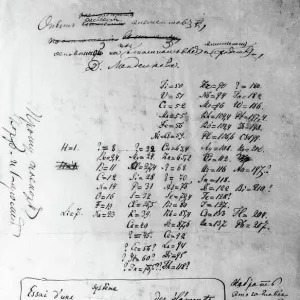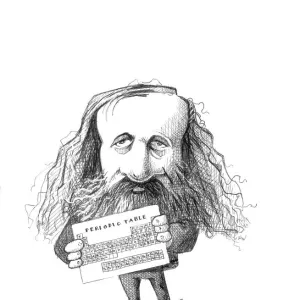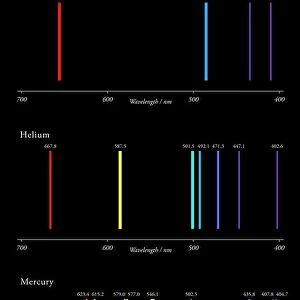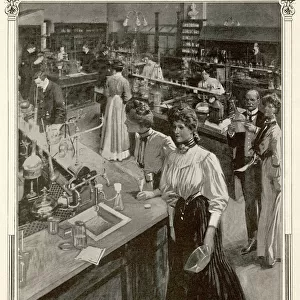Home > Granger Art on Demand > Plans and Diagrams
Dmitri Mendeleyevs Periodic Table in which the elements are arranged by atomic weight in groups of related chemical and physical properties, early 20th century
![]()

Wall Art and Photo Gifts from Granger
Dmitri Mendeleyevs Periodic Table in which the elements are arranged by atomic weight in groups of related chemical and physical properties, early 20th century
MENDELEYEV: PERIODIC TABLE.
Dmitri Mendeleyevs Periodic Table in which the elements are arranged by atomic weight in groups of related chemical and physical properties, early 20th century
Granger holds millions of images spanning more than 25,000 years of world history, from before the Stone Age to the dawn of the Space Age
Media ID 10407904
Chemist Chemistry Diagram Dimitri Element Ivanovich Russian Mendeleev Periodic Table
EDITORS COMMENTS
This print showcases Dmitri Mendeleyev's groundbreaking Periodic Table, a pivotal scientific achievement of the early 20th century. Mendeleyev, a Russian chemist and visionary, meticulously arranged the elements according to their atomic weight while grouping them based on their related chemical and physical properties. The Periodic Table depicted in this image is an iconic representation of Mendeleyev's genius and enduring legacy in the field of chemistry. The diagram captures his meticulous attention to detail as he sought to organize the vast array of known elements into a coherent system. Mendeleyev's revolutionary approach revolutionized our understanding of matter by revealing patterns and trends among different elements. This visual representation became an indispensable tool for scientists worldwide, enabling them to predict undiscovered elements and understand their behavior. As we gaze upon this historical artifact, we are reminded not only of Mendeleyev's brilliance but also his unwavering dedication to advancing human knowledge. His work laid the foundation for countless scientific breakthroughs that continue to shape our world today. This print serves as a testament to Mendeleyev's invaluable contribution to science and stands as a tribute to his profound impact on chemistry education across generations. It invites us all to appreciate the beauty and complexity inherent in nature's building blocks – the elements – which form the very fabric of our universe.
MADE IN THE USA
Safe Shipping with 30 Day Money Back Guarantee
FREE PERSONALISATION*
We are proud to offer a range of customisation features including Personalised Captions, Color Filters and Picture Zoom Tools
SECURE PAYMENTS
We happily accept a wide range of payment options so you can pay for the things you need in the way that is most convenient for you
* Options may vary by product and licensing agreement. Zoomed Pictures can be adjusted in the Cart.













